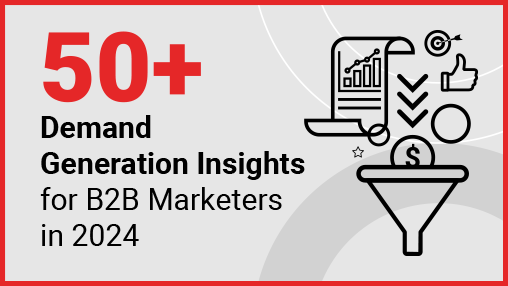To ensure your demand generation efforts deliver strong results, it’s crucial to stay up to date with the latest statistics. This knowledge enables you to tweak your strategy, improve brand awareness, and deliver high-quality leads.
We’ve compiled some of the most relevant demand generation statistics from third-party and our own first-party research, providing key recommendations based on these insights to help you effectively enhance your marketing strategies.
- Market growth and trends statistics
- Lead generation strategies and effectiveness statistics
- Content strategy and buyer preferences statistics
- Challenges and priorities in lead nurturing
- Insights into the early buyer journey
- Mid-funnel preferences and engagement strategies
- Decision-making phase strategies
- Challenges and priorities for demand gen marketers
- Demand generation ROI statistics
- Demand generation budget statistics
Market growth and trends
- In 2022, the worldwide market for demand generation software was valued at USD 4,486.39 million and is projected to grow to USD 8,350.8 million by 2028. This growth represents a Compound Annual Growth Rate (CAGR) of 10.91% from 2022 to 2028. (Source)
Lead generation strategies and effectiveness
Are you optimizing your lead generation efforts effectively? Understanding which strategies attract and convert B2B leads is crucial to staying ahead of lead generation trends.
Here’s a look at some key statistics revealing the top strategies for gathering B2B leads:
- Approximately 30% of B2B firms consider content syndication as one of their most effective lead generation tactics (Source)
- Webinars are considered the most effective top-of-the-funnel demand generation tactic by 45% of B2B marketing practitioners (Source)
- Webinar content is the top-of-the-funnel format that generates the most high-quality leads, according to 53% of marketers (Source)
- LinkedIn drives 80% of B2B leads, highlighting its effectiveness as a key channel for lead generation (Source)
- 15% of B2B marketers consider organic search a crucial lead source for sales and marketing, close to account-based marketing at 17% (Source)
Content strategy and buyer preferences
From initial interest to final decision, understanding buyer preferences and optimizing content strategy is essential. Here’s a look at insights that underscore the importance of content in guiding decision-makers:
- Content has a significant impact on buying decisions according to 81% of buyers (Source)
- Decision-makers typically consume between 3 – 13 pieces of content before engaging with a sales representative and making a purchase (Source)
- Short-form content and webinars/digital events are increasingly favored by prospects and buyers at 67% and 65%, respectively (Source)
- Educational B2B blogs generate 52% more organic traffic (Source)
- Content marketing helped 76% of B2B marketers generate demand/leads in 2023, up from 67% in 2022 (Source)
- The most effective marketing strategies for demand generation efforts are content marketing (83%), organic SEO (67%), and paid advertising (53%) (Source)
- 95% of those surveyed agree to some extent with the statement, “Demand generation is significantly improved when a data-driven strategy is used” (Source)
Challenges and priorities in lead nurturing
Marketers face significant challenges in nurturing leads effectively. Key insights shed light on these obstacles and priorities:
- 47% of marketers said developing targeted content by buyer stage / interest is one of the biggest challenges they face with their lead nurturing initiatives. Learn how effective content mapping can help you overcome this challenge and guide buyers through their journey (Source)
- 43% said building the right timing / workflows for campaigns is a challenge (Source)
Insights into the early buyer journey
Understanding early-stage buyer preferences and behaviors is critical for effective engagement:
- 72% find blog posts/news articles most valuable, followed by webinars (60%), research reports (59%), and infographics (58%) (Source)
- Nearly half of B2B buyers shortlist around 2 to 4 vendors when purchasing a new tech solution, indicating… (B2B Tech Buying Report | Inbox Insight)
- Software comparison websites are preferred by 59% of buyers, indicating reliance on comparative analysis to understand business challenges (B2B Tech Buying Report | Inbox Insight)
- 46% of buyers use generative AI tools like ChatGPT for preliminary research, reflecting growing trust in AI-driven insights (B2B Tech Buying Report | Inbox Insight)
Mid-funnel preferences and engagement strategies
Tweaking engagement strategies in the mid-funnel stage is crucial for guiding decision-makers towards conversion:
- Case studies are highly preferred by 78% of decision-makers, followed by webinars (58%), user reviews (57%), and analyst reports (54%) (Source)
- Generative AI tools are used by 38% of B2B decision-makers but are less trusted compared to established sources like comparison websites, which are trusted by 55% (B2B Tech Buying Report | Inbox Insight)
- When evaluating technical solutions, newsletters/email bulletins are the least favored by B2B marketers at 14%. Instead, buyers prefer visiting product review sites in the mid-funnel stage (B2B Tech Buying Report | Inbox Insight)
- Just over a third (41%) of buyers strongly agree or agree that they find it difficult to find trustworthy information about technology solutions online (B2B Tech Buying Report | Inbox Insight)
Decision-making phase strategies
Personalization is key in the decision-making phase to enhance buyer engagement and conversion:
- Demos (77%), user reviews (63%), assessments (61%), and ROI calculators (60%) are prioritized by decision-makers (Source)
- When mapping lower funnel content to the buying process, 59% of B2B decision-makers said product sheets and 53% said case studies help them evaluate a shortlisted vendor solution with greater ease (B2B Tech Buying Report | Inbox Insight)
- Regarding the type of educational support decision-makers expect from B2B vendors, one-to-one consultations with subject matter experts were the most sought after at 72%, followed by thought leadership content at 45% (B2B Tech Buying Report | Inbox Insight)
- 51% of buyers expect high to very high levels of personalization when researching and buying a B2B solution (B2B Tech Buying Report | Inbox Insight)
Marketing key takeaway:
“To meet increased personalization demands, customize content for each persona in the decision-making unit, tailor outreach with personalized insights per account, and implement an Account-Based Marketing (ABM) strategy using prioritization (1-to-1, 1-to-few, and 1-to-many) to optimize budget efficiency and effectiveness.”
Challenges and priorities for demand gen marketers
Understanding the key challenges and priorities for demand generation specialists is essential for developing effective B2B marketing strategies. The following statistics highlight the critical areas of focus:
- 24% of marketers claim their biggest challenge is creating content that generates leads (Source)
- Over half (53%) of senior marketers find the predominant emphasis on sales and bottom-funnel content to be a major challenge, while nearly half struggle with crafting impactful messages due to insufficient insights (Source)
- 73% of B2B marketers feel they are only somewhat successful in implementing strategies for data-driven demand programs (Source)
- 74% of B2B marketing leaders cite maximizing data value and comprehending its insights as their top data challenge (Source)
- 98% view B2B intent data as crucial for successful demand generation (Source)
For more stats related to intent data, read our blog post for more insight.
- AI tools are used by 90% of marketers for producing personalized content (Source)
- 67% of marketers said they need to better understand customer needs / preferences to meet their organization’s demand generation goals (Source)
- 54% have encountered data quality issues with demand generation vendors (Source)
- 99% of B2B marketers believe that their brand strategy significantly influences their demand generation programs. However, despite this alignment, 40% identify unqualified leads as their main challenge within sales and marketing funnels (Source)
- 45% of B2B marketers said promoting better sales and marketing alignment around go-to-market initiatives was their top demand generation priority for 2023 (Source)
- 41% report difficulties in measuring demand generation program results (Source)
- 58% of decision-makers see lead generation as a primary challenge for business leaders (Source)
Demand generation ROI statistics
Understanding how organizations measure ROI is crucial for developing effective strategies. Digital Zone’s recent findings offer critical insights into the demand generation metrics organizations prioritize to assess marketing effectiveness.
Top metrics for measuring ROI:
- 43% of organizations cite overall spend as a key indicator
- Conversion rates and cost per lead (CPL) each play a pivotal role for 40% of respondents
- Nearly 39% gauge success through site traffic and lead volume
Strategies for ROI optimization:
- Increasing the diversity of marketing channels is a tactic for 43% of organizations, suggesting a move towards omnichannel engagement
- About 42% are fine-tuning active campaigns, indicating a proactive stance on campaign management
- 40% aim to enhance efficiency by reducing overall spend, showcasing a strategic focus on cost-effectiveness
- 37% are narrowing their channel focus to invest in the most effective platforms, while an equal percentage adjust their strategies between retention and acquisition to optimize ROI
By taking these statistics and strategies into consideration, businesses can navigate demand generation complexities more effectively, deploying resources strategically for maximum impact and efficiency.
Demand generation budget statistics
Budget allocation and effectiveness are critical for sustaining and scaling marketing efforts. Key insights include:
- 26% of marketing budgets are wasted on strategies that don’t yield the desired outcomes (Source)
- 42% of organizations plan to increase their budgets throughout 2023, despite challenges (Source)
- More than 75% of companies are striving to meet aggressive growth goals, even with tighter budgets (Source)
- Budgets are being strategically allocated:
- 46% are emphasizing account-based marketing
- 43% are focusing on content marketing
- 38% are investing more in sales enablement
Need support to help you find more highly qualified leads? Contact Inbox Insight – your experienced demand generation partner known for delivering strong results.






